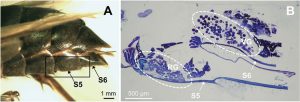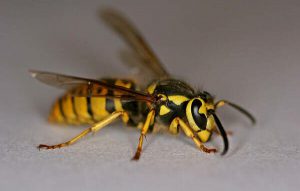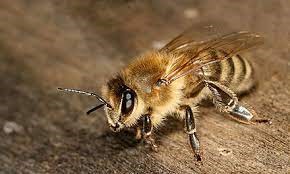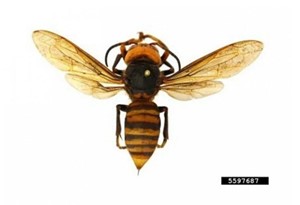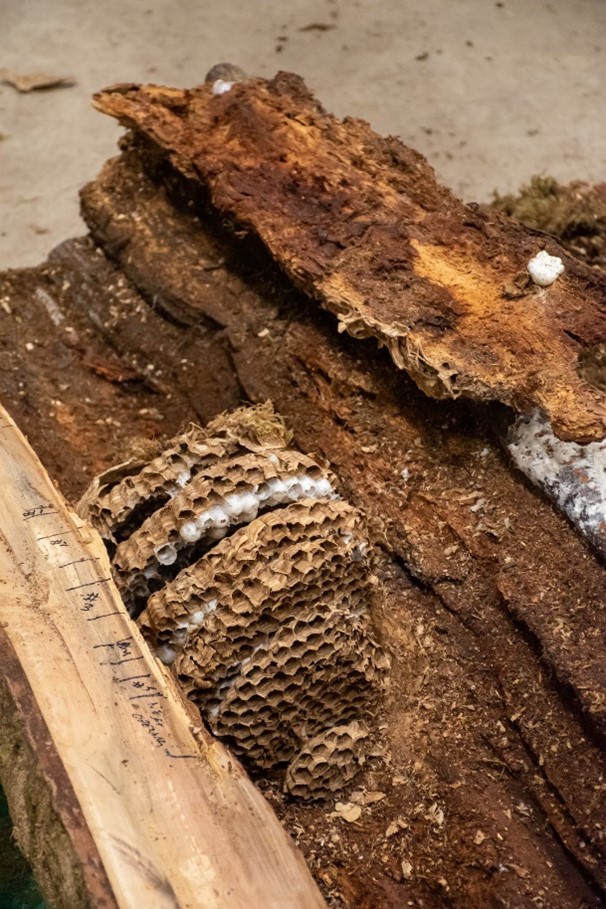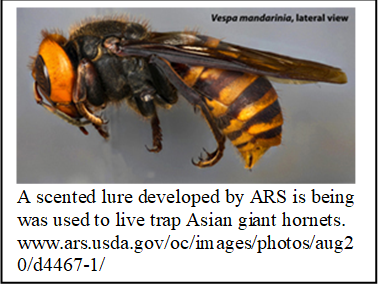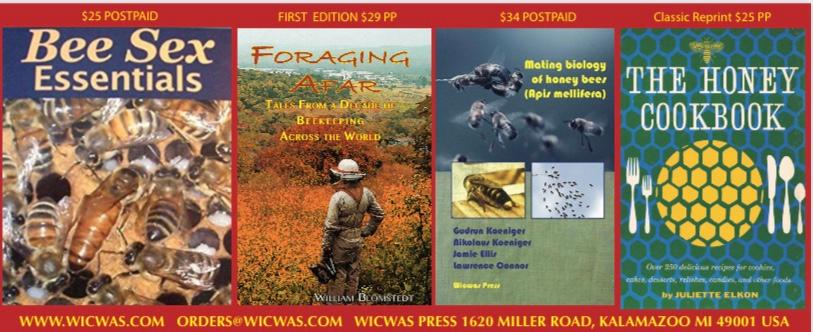By: Gard W. Otis
The Yellow-legged Hornet, Vespa velutina, has been discovered in the state of Georgia! This social wasp, native to Asia, preys extensively on honey bees and other pollinators. Its arrival in North America, while not wholly unexpected, is a cause for alarm for beekeepers and agriculture in general. What is this wasp? Why is it a concern? What can we do to control it? And how concerned should we be at this time?
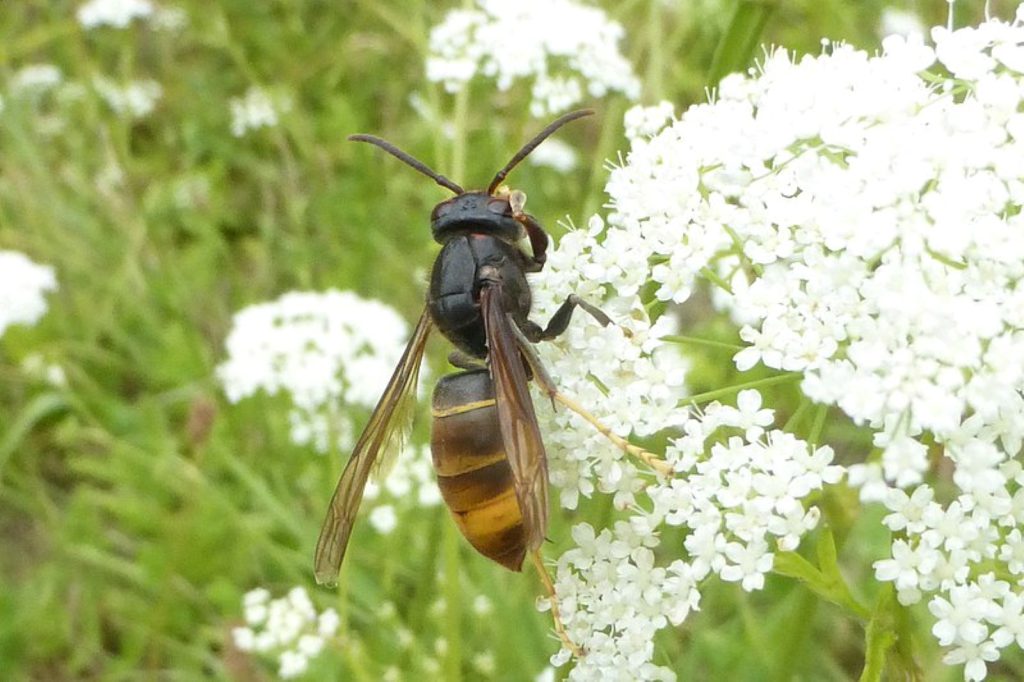
Figure 1. Yellow-legged Hornet, Vespa velutina, at rest. Photo taken in France, courtesy of Patrick Le Mao
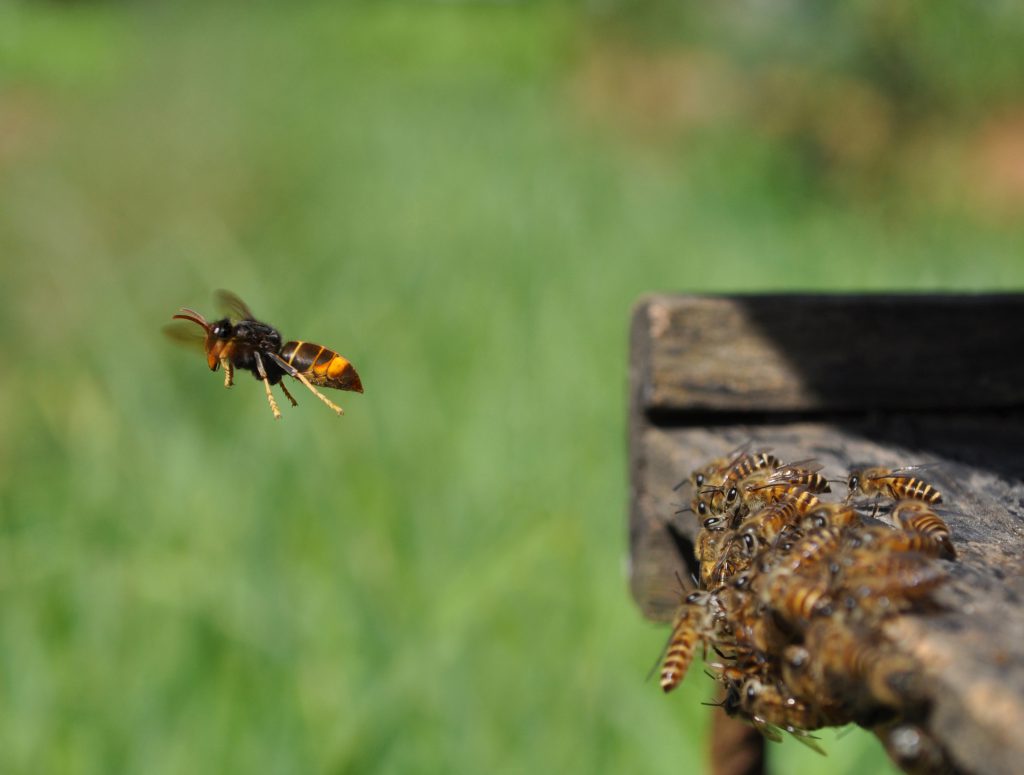
Figure 1. A Yellow-legged Hornet hovers in front of a hive, awaiting incoming forager bees. Photos taken in France, courtesy of Quentin Rome / Muséum national d’Histoire naturelle, Paris, France.
V. velutina is a large wasp, approximately 0.7–1.0 inch (1.7–2.5 cm) in length and with distinctive yellow legs (Fig. 1). It is a social insect, with colonies composed of numerous workers and a slightly larger queen (Pérez-de-Heredia et al., 2017). The species has been studied extensively, both within its native range and in the regions of western Europe, South Korea and Japan it has invaded. Its colonies, founded by a single mated queen, become more populous as Summer progresses. By late Summer, its large, round papery nests, usually concealed by leaves in tree-tops, contain hundreds of worker hornets. To feed their larvae, they capture a wide variety of insects, with the Western Honey Bee (Apis mellifera) being a favored prey species, in part because stationary honey bee colonies provide food consistently for weeks on end (Fig. 1; Roy, 2023). Laurino et al. (2020) provided a review of the biology of the species and its invasion of Europe, where programs to control the species cost millions of dollars annually.
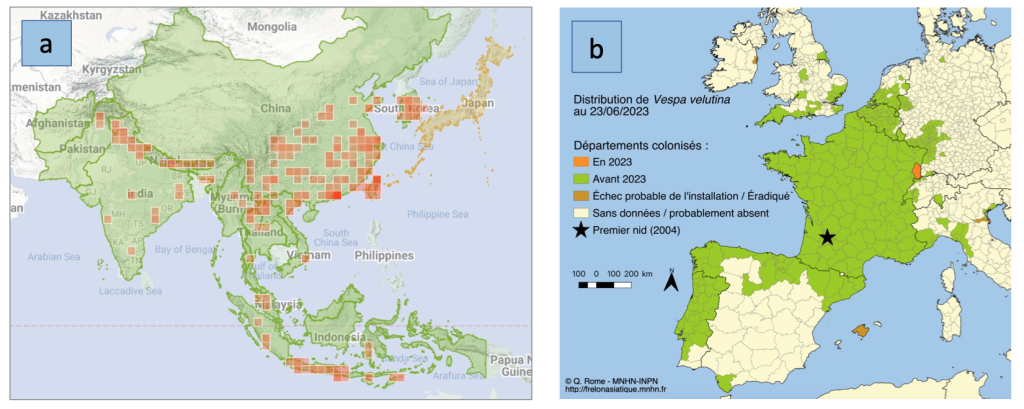
Figure 2. Distribution of V. veluntina (a) in Asia where it occurs naturally and has been introduced to South Korea and Japan, and (b) in Europe where it has been introduced. The red dot indicates where the first hornets were discovered in 2004. (Maps from (a) iNaturalist.org and (b) INPN (2023), used with permission of Quentin Rome / MNHN
Vespa velutina naturally inhabits a region that extends from northern China south through Indonesia and Southeast Asia, and westward along the foothills of the Himalayas to Afghanistan (Fig. 2a). Over that range, it occurs in 13 different color forms (formerly referred to as subspecies). It is likely that the hornets in Georgia are of the northern mainland form, V. velutina nigrothorax, that has also invaded Europe (Fig. 2b) and northeastern Asia. V. v. nigrothorax has often been inappropriately referred to in much of the literature written about it as the “Asian hornet”, a misnomer given that all 22 species of hornets inhabit some part of Asia!
The life cycle of the Yellow-legged Hornet is generally the same as that of all species of hornets (i.e., wasps in the genus Vespa) in temperate climates (Laurino et al., 2020). A mated queen emerges from her wintering site and becomes active in Spring when the weather becomes suitable. After a period of feeding on floral nectar and tree sap, followed by dispersal estimated to exceed 30 miles (50 km) in some instances, she individually constructs a small comb enclosed within a papery envelope made from plant fibers she chews and mixes with her saliva. The queen then rears the first generation of hornets by herself in an “embryo nest.” When those first workers have completed their development and emerge as adults, they take over most colony activities (nest construction, brood care, foraging and colony defense) while the queen continues to lay most, if not all, eggs. Towards Fall, the colony rears new queens and males. Those new queens mate with males, search for a wintering site that is usually in soil, leaf litter or rotten wood, and become quiescent for several months while temperatures are too cool for activity. It is while they are in Winter diapause that the queens can be accidentally transported long distances as stowaways among cargo on ships and, less frequently, on planes. This is almost certainly how Yellow-legged Hornets arrived in Georgia: the sites where the first individuals were discovered are within 12 miles of the Port of Savannah, one of the largest shipping ports in North America that receives cargo from everywhere in the world.
One important difference between the Yellow-legged Hornet and other species is the relatively large number of males with which young queens mate. The majority of hornet species that have been studied, mate with one or sometimes two males. In contrast, V. velutina queens mate with three males on average (range from one to 5+). The invasion of Europe by this species is believed to have originated from a single queen, mated with four males, that was accidentally imported to southwestern France (Fig. 2b). The added genetic variability provided by mating with several males has undoubtedly contributed to its successful invasions (reviewed by Otis et al., 2023).
Vespa velutina colonies can become very large. Quentin Rome and his colleagues (2015) collected nests in southwestern France from June to November and quantified their populations of immature and adult hornets. The colonies, generally initiated in March, had an average of 440 worker hornets by late October and early November. Some of those nests remained very small, but the most populous colony had 1,740 workers (News reports that colonies may contain 6,000 or more workers are erroneous). Mature colonies in Fall contained an average of 190 new queens (Rome et al., 2015), but because young queens only remain in their nest for about two weeks, that number must represent only a portion of all queens reared. I estimate that the average number reared is approximately 300–400 per colony. The greatest number of new queens collected inside one single nest was 463.
In an odd quirk of biology, hornet larvae serve as reservoirs of food within their colony. Larvae convert the proteins in chewed-up insect prey collected by worker hornets into amino-acid rich sugars. They then feed those secretions to young queens, resulting in them increasing in weight by 20–40% within one to two weeks of emergence as adults due to deposition of fat that fuels their survival during several months of Winter diapause. Young males also require the nutrients provided by larvae in order to mature sexually. Because hornets do not store honey in their nests, the sugary secretions from larvae also sustain their colonies during periods of inclement weather when foraging is not possible (reviewed by Otis et al. 2023).
How does the Yellow-legged Hornet affect honey bees and other pollinators?
The greatest concern related to the establishment of Yellow-legged Hornets in North America is their effects on honey bees and other pollinators. These hornets capture a wide variety of flying insects, a high percentage of which are pollinators, to feed to their larvae. Honey bees in particular are heavily preyed upon. Hornets hover near a hive entrance, facing outwards, so they can pick off incoming foragers (Fig. 1). Once a hive has been located, a hornet can return repeatedly to prey upon the essentially defenseless honey bees. Dr. Yves Le Conte, former head of the French honey bee research unit in Avignon, told me that by late Summer, when honey bees colonies should “prepare good Winter bees and collect honey for Winter survival, the hornets put pressure on the bees.” Hornets seem to focus on weaker colonies and in some cases, once they have killed most of the bees in a hive, they may enter and eat both the brood and the honey. In addition to the constant attrition of foraging bees, the presence of multiple hornets at the entrance of a colony causes “foraging paralysis” in extreme cases, flight activity is completely suppressed. The reduced foraging results in low honey stores and Winter starvation, with losses of 30–50% often reported (Yves Le Conte, pers. comm.; Requier et al., 2019). This hornet is a very significant threat to honey bees!
What has happened in Georgia in 2023?
From the information I have been able to obtain, Yellow-legged Hornets were first observed on or before August 1st by Sarah Beth Waller (personal communication), the beekeeper at the Savannah Bee Company on the eastern edge of Savannah where they were feeding on fallen pears. She posted a photo to iNaturalist on August 7th that yielded a tentative identification of the hornet as Vespa velutina (iNaturalist, 2023). Also in early August, a beekeeper somewhere in Savannah (at a date and location that have yet to be revealed by the Georgia Department of Agriculture) collected two hornets as they visited his hives. They were identified first by a University of Georgia entomologist and subsequently confirmed by the USDA on August 9th (GDA, 2023a). Thanks to news reports on August 15th about this discovery, a homeowner in the vicinity of the Savannah Bee Company reported a large nest 75 feet up in a pine tree. That nest, destroyed on the evening of August 23rd, proved to be exceptionally large (GDA 2023a, b). Keith Delaplane (University of Georgia) informed me that hornet traps of an unknown type have been deployed by the GDA from Port Wentworth to the mouth of the Savannah River, a distance of 18 miles. One person I interviewed was of the understanding that the first two locations where the hornets were observed are approximately eight miles apart, which, if true, would suggest that additional colonies may be present (hornets usually forage within a mile of their nest). Hornets have been sent for genetic analysis to determine if they originated in Europe or Asia. The situation in Savannah is fluid and changing rapidly. By the time this article is published, much more will be known and divulged. It may take a year or more before we know whether this incipient infestation has been eradicated.
What can be done to reduce the threat posed by the Yellow-legged Hornet?
Traps of many designs have been developed and tested in Europe. They have proven moderately effective for monitoring the presence of the hornet, but do not catch sufficient hornets to appreciably affect established colonies. Moreover, they have been criticized for their extensive by-catch of non-target insects. If the traps that have been deployed in Georgia capture additional hornets, finding and destroying their nests before new queens disperse into the environment presents the greatest probability of successful eradication. As an example, in spite of repeated discovery of Yellow-legged Hornet colonies in southern England, coordinated efforts of agricultural personnel, beekeepers and scientists have so far been successful at preventing the wasp’s establishment in the United Kingdom (Jones et al., 2020). On the Mediterranean island of Mallorca, the combination of Spring trapping of gynes before they establish nests, baiting for foragers, and triangulating and destroying colonies before they produce new queens, eliminated the initial infestation. There have been some successes in using very light-weight radio transmitters to track Vespa hornets to their nests (Kennedy et al., 2018; Looney et al. 2023). After a few years, however, once a population of hornets has become established, the proportion of nests that can be found and destroyed has proven in several European countries, to be insufficient to control the invasion.
Monitoring by state departments of agriculture (e.g., see the online form set up for reporting in Georgia; GDA 2023a) or through community-scientist platforms such as iNaturalist can provide accurate reporting of exotic hornets and other pests. Beekeepers can play a huge role in early detection of non-native hornets because several species that have the potential to become established in North America prey extensively on honey bees. Any wasp that seems unusual can be photographed or caught in a jar, then compared with similar species (USDA-APHIS, 2023). It should be reported if you suspect it is V. velutina or another non-native species.
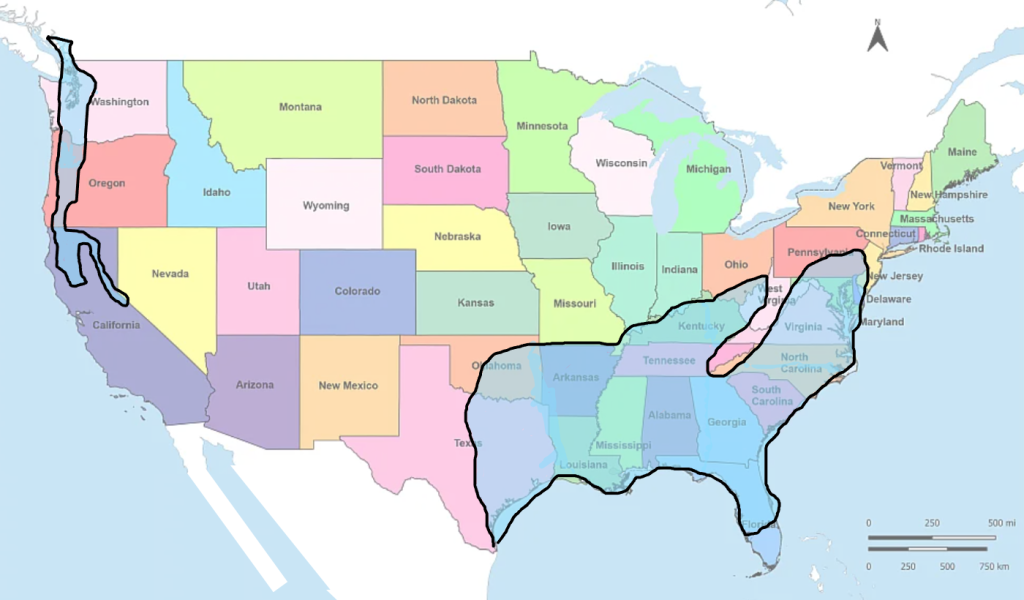
Figure 3. Regions of North America with climate well suited to Yellow-legged Hornet survival. Other regions with lower climate suitability not shown. Adapted from Villemany et al. (2011).
Where is the Yellow-legged Hornet likely to survive in North America?
GIS technology coupled with climate data for localities throughout the world that are available online have revolutionized our ability to predict potential distributions of species outside of their native ranges. In the case of the Yellow-legged Hornet, climate variables from where the species has been documented in Asia as well as in its introduced range in France, were analyzed along with climate data for sites throughout the rest of the world. A map showing the probability of suitable climate for hornet survival was created (Villemant et al., 2011). I superimposed the North American portion of that map onto a map of the United States, then modified it to show the approximate regions in North America where Vespa velutina would almost certainly be able to survive and reproduce (Fig. 3).
A large area of southeastern USA is predicted to have climate suitable for V. velutina. That region extends from the southern tip of Texas north into Oklahoma, then eastwards to somewhere between Baltimore and New York (Fig. 3.). Hornet survival may even be possible as far north as Boston and southern Ontario (Villemant et al., 2011). On the west coast, there is a zone in the rain shadow of the coastal mountains, from Vancouver, Canada, south into California, that seems prone to invasion. The hornet is likely to do better where the minimum temperature in Winter is not too cold, relative humidity is fairly high and the maximum temperature in Summer is not too hot.
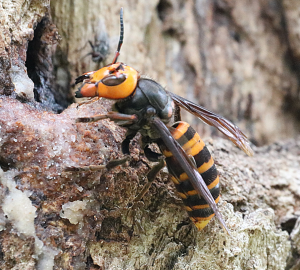
Figure 4. The Northern Japanese Hornet, Vespa mandarinia, a species that invaded the Pacific Northwest in 2019. Photo taken by Aline Horikawa near Kyoto, Japan, and used with her permission.
What about other exotic species of hornets?
Who can forget the “invasion by murder hornets” in 2019–2021? The Northern Giant Hornet (formerly known as the Asian Giant Hornet), Vespa mandarinia, is a huge social hornet (Fig. 4; also, refer to the image within YLH lookalikes” in USDA-APHIS, 2023) that is infamous for its ability to rapidly slaughter entire colonies of Apis mellifera. Its discovery in Fall of 2019 led to an extensive monitoring and eradication effort that is on-going in Washington state and British Columbia. Following a peak of 35 sightings and specimens in 2020, there were only 10 reports in 2021 (Looney et al., 2023). Since then, there have been no Northern Giant Hornets detected in North America, and there is optimism that the introduction of this species has failed. It is not clear what combination of factors is responsible for the decline in its population: relatively unsuitable climate, low genetic diversity, destruction of nests (one in British Columbia, four in Washington state; Looney et al. 2023) or other factors. It is known that relatively few species that reach foreign lands are successful in establishing permanent populations. We may simply have gotten lucky with the recent Northern Giant Hornet introduction.
Several groups of researchers have modeled the potential distribution of V. mandarinia. All of them yielded a strong probability of it surviving in the Pacific Northwest where it was initially discovered as well as a large region of eastern North America; however, these models fail to agree on the regions in the east that are most prone to invasion. Because this species focuses its predation in late Summer and Fall on social insects, including honey bees, beekeepers are again the group most likely to encounter it. If you see any wasp attacking and killing honey bees, you should report it immediately.
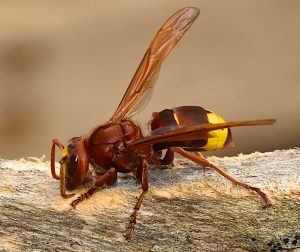
Figure 5. The Oriental Hornet, Vespa orientalis, a demonstrated invader in northern Italy, southern France, Sardinia, southern Spain, eastern Europe and Chile. Photo taken by Nicola Addelfio near Palermo, Sicily, Italy, and used with her permission.
The Oriental Hornet (Vespa orientalis: Fig 5.), naturally inhabits the Mediterranean, Middle Eastern and western Asian countries and is the only hornet species adapted to hot, arid climates. This striking reddish brown hornet is an agricultural pest that attacks honey bee colonies and damages fleshy fruits such as grapes. It has already been detected in at least 10 countries outside of its native range (reviewed by Otis et al., 2023), and has successfully colonized southern Spain and Chile. Young queens often Winter in groups (Eran Levin, pers. comm.), a behavior which may have helped it to overcome genetic bottlenecks. Species distribution modeling suggests it has a high probability of successfully colonizing the Gulf Coast region of the United States as well as central California.
I would be remiss not to mention the European Hornet, also a large wasp that could be mistaken for one of the other species mentioned (USDA-APHIS, 2023). It was accidentally introduced to New York City nearly 180 years ago and has become relatively common in much of Eastern North America, but because it rarely captures honey bees and has relatively small colonies, it has not proven to be a concern for beekeeping.
Conclusion
Several hornet species cause extensive damage to honey bee colonies in other parts of the world. Unlike Varroa mites and small hive beetles, hornets do not inhabit bee colonies and would be very unlikely to be transported with hives when they are moved for pollination. However, they do have the potential to arrive at any port and subsequently be transported by trucks and trains anywhere in North America! The establishment of any of the exotic hornets discussed before would cause extensive disruption to beekeeping due to their predation on bees and secondary effects on Winter colony survival. The propensity of these hornets to attack honey bees makes beekeepers the most likely people to encounter them, as demonstrated recently with the detection of the Yellow-legged Hornet in Georgia. Readers are encouraged to learn how to identify them: review the figures in this article and “lookalikes” in USDA-APHIS (2023). Stay vigilant—and let’s hope that we remain “hornet-free” for many years to come.
Acknowledgments
I am indebted to Lien T.P. Nguyen of Vietnam and Heather Mattila of Wellesley College, MA, my hornet research collaborators, for the knowledge and experiences they have shared with me over the past decade. Staff at the University of Georgia, K. Cecelia Sequira of USDA-APHIS, and Sarah Beth Waller shared important information about the Yellow-legged Hornet detection in Georgia up until 27 August, 2023. I must also recognize the dozens of wasp biologists worldwide who have willingly answered my many naive questions about hornets.
Gard W. Otis
School of Environmental Sciences, University of Guelph, Ontario, Canada
Institute of Bee Health, University of Bern and Agroscope, Bern, Switzerland
Selected References
GDA (2023a). Georgia Department of Agriculture press release (Aug. 25, 2023). https://agr.georgia.gov/pr/yellow-legged-hornet-nest-eradicated-savannah-area
GDA (2023b) Georgia Department of Agriculture press conference (Aug. 25, 2023). https://www.facebook.com/watch/live/?ref=watch_permalink&v=639982398259487
iNaturalist (2023). Yellow-legged Hornet (Vespa velutina). https://www.inaturalist.org/taxa/119019-Vespa-velutina
INPN (2020). Le frailon asiatique, Vespa velutina. (The Asian Hornet, Vespa velutina). Inventarie National du Patrimoine Naturel. (http://frelonasiatique.mnhn.fr/)
Jones E.P., C. Conyers, V. Tomkies, et al. Managing incursions of Vespa velutina nigrithorax in the UK: an emerging threat to apiculture. Scientific Reports (2020) 10:19553. doi: 10.1038/s41598-020-76690-2
Kennedy P.J., S.M. Ford, J. Poidatz, et al. (2018). Searching for nests of the invasive Asian hornet (Vespa velutina) using radiotelemetry. Communications Biology 1: 88. doi: 10.1038/s42003-018-0092-9
Laurino D, S. Lioy, L. Carisio, et al. (2020). Vespa velutina: an alien driver of honey bee colony losses. Diversity (2020) 12: 1–15. doi:10.3390/d12010005
Looney, C, B. Carman, J. Cena, et al. (2023) Detection and description of four Vespa mandarinia (Hymenoptera: Vespidae) nests collected in Washington State, USA. Journal of Hymenoptera Research 96: 1–20. https://doi.org/10.3897/jhr.96.99307
Otis, G.W., B.A. Taylor, and H.R. Mattila (2023). Invasion potential of hornets (Hymenoptera: Vespidae: Vespa spp.). Frontiers in Insect Science 3: 1145158. https://doi.org/10.3389/finsc.2023.1145158
Pérez-de-Heredia, I, E. Darrouzet, A. Goldarazena, et al. (2017). Differentiating between gynes and workers in the invasive hornet Vespa velutina (Hymenoptera, Vespidae) in Europe. Journal of Hymenoptera Research 60: 119–133. https://doi.org/10.3897/jhr.60.13505
Requier, F., Q. Rome, G. Chiron, et al. (1019), Predation of the invasive Asian hornet affects foraging activity and survival probability of honey bees in Western Europe. Journal of Pest Science 92: 567–578.
Rome, Q., F.J. Muller, A. Touret-Alby, et al. (2015). Caste differentiation and seasonal changes in Vespa velutina (Hym.: Vespidae) colonies in its introduced range. Journal of Applied Entomology 139: 771–782. https://doi.org/10.1111/jen.12210
Roy, H. (2023). BBC. Asian hornet guide. https://www.discoverwildlife.com/animal-facts/insects-invertebrates/asian-hornets-guide/
USDA-APHIS (2023). Yellow-legged Hornet. https://www.aphis.usda.gov/aphis/ourfocus/planthealth/plant-pest-and-disease-programs/honey-bees/yellow-legged-hornet (accessed 25 August, 2023).
Villemant C., M. Barbet-Massin, A. Perrard, et al. (2011). Predicting the invasion risk by the alien bee-hawking yellow-legged hornet Vespa velutina nigrithorax across Europe and other continents with niche models. Biological Conservation 144: 2142–50. doi: 10.1016/j.biocon.2011.04.009
The spotting of a new predatory hornet in Georgia could mean trouble for Florida’s imperiled honey bees if it spreads further South.
To track the spread of the yellow-legged hornet, scientifically named Vespa velutina, UF/IFAS honey bee experts are working with the Florida Department of Agriculture and Consumer Services to spread the word on what residents can do if they see or catch one of these hornets.
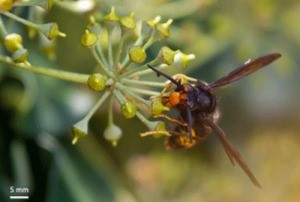
Karine Monceau, from Monceau et al. 2014 A yellow-legged hornet, a predator to the honey bee, sits on a plant.
“Honey bees in North America have no natural defenses against the yellow-legged hornet, so keeping this species from making a home in Florida is of the utmost importance to our honey bee populations and thus our food supply,” said Amy Vu, state specialized program extension agent for the University of Florida/IFAS Honey Bee Research and Extension Laboratory.
The Vespa velutina is an invasive hornet that preys on honey bees and honey bee larva. The first United States sighting of the predator, which has already damaged Europe’s bee populations, was last week in Savannah, Georgia, by the Georgia Department of Agriculture after a backyard beekeeper spotted, captured and reported two hornets.
The yellow-legged hornet is smaller, but similar to the Vespa mandarinia, known by its nickname the “murder hornet,” which has a distinct orange mark on its head.
The yellow-legged hornet is best identified by its yellowish-white-colored legs, is about 1.2 centimeters to 3 centimeters long, and has a broad orange-yellow face with large, prominent eyes. The thorax and abdomen are mostly black with a single yellow section near the end of the abdomen, according to UF/IFAS informational documents.
The yellow-legged hornet is often mistaken with the commonly seen European hornet, Vespa crabro, which is not a substantial threat to bees. The European hornet does not have yellow/white legs. European hornet samples should not be submitted, if possible.
To report a suspected yellow-legged hornet email [email protected] or call the FDACS hotline at 1-888-397-1517.
We are here to share current happenings in the bee industry. Bee Culture gathers and shares articles published by outside sources. For more information about this specific article, please visit the original publish source: https://www.mainstreetdailynews.com/local-living/outdoors/uf-ifas-warns-bee-predator-georgia
]]>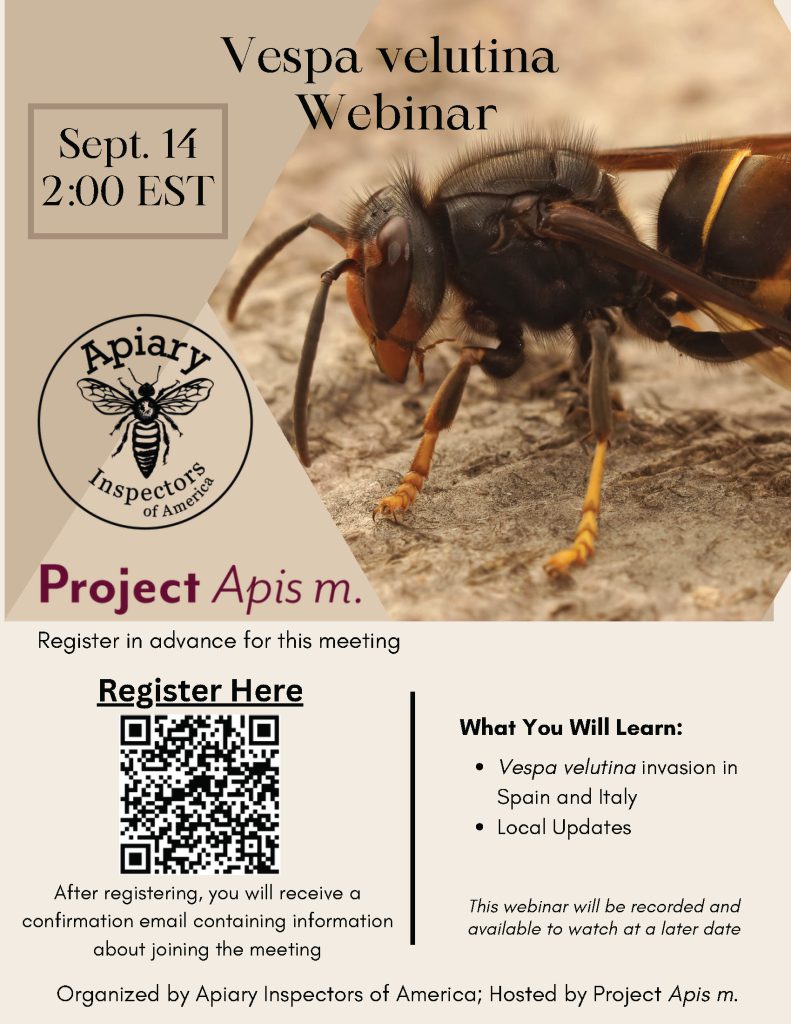
Links:
Register Here: https://us02web.zoom.us/meeting/register/tZArdemgrzovEtapijKNqDIVQ7WI5Y3GiQyp
]]>To prevent the spread of this destructive hornet throughout the South, UF/IFAS experts are collaborating with the Florida Department of Agriculture and Consumer Services. They are determined to raise awareness among residents about what they can do if they encounter or capture one of these hornets.
Photos:
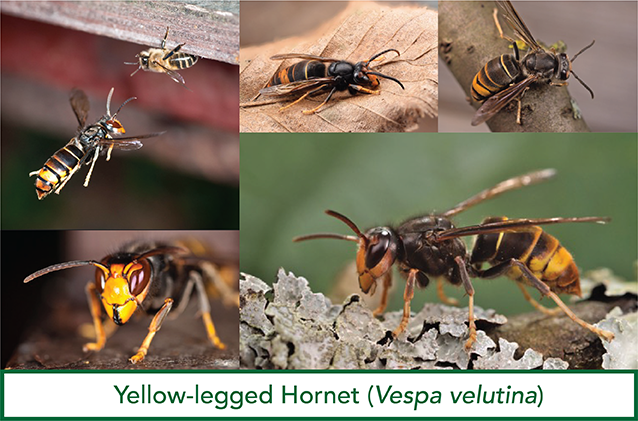
Yellow legged hornet: Various views of Vespa velutina. Credit: Georgia Department of Agriculture
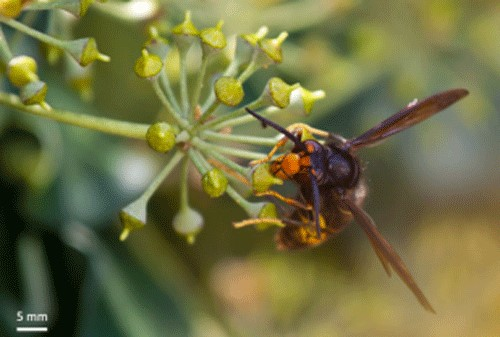
Yellow legged hornet: Vespa velutina feeding on nectar. Credit: Karine Monceau, from Monceau et al. 2014
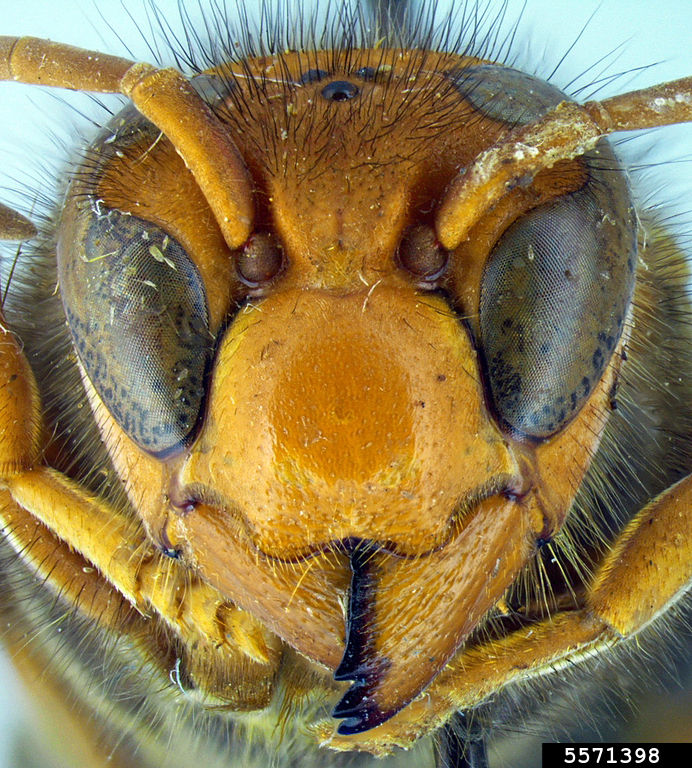
Yellow legged hornet: An invasive yellow-legged hornet. Credit: Allan Smith-Pardo, USDA APHIS PPQ, Bugwood.org
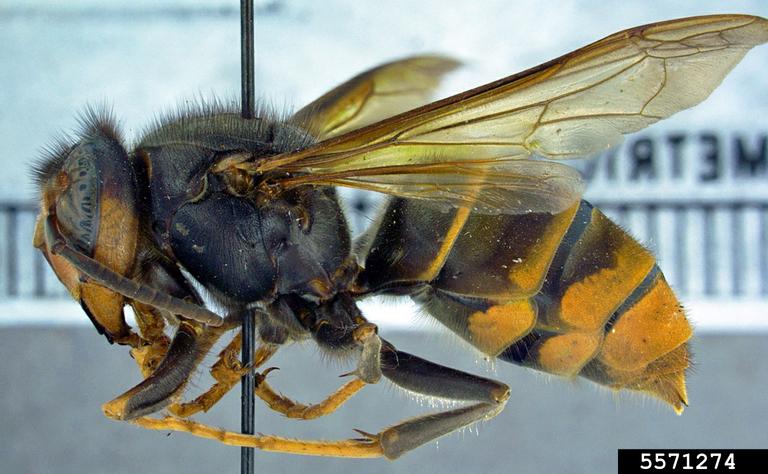
Yellow legged hornet: An invasive yellow-legged hornet. Credit: Allan Smith-Pardo, USDA APHIS PPQ, Bugwood.org
Meredith Bauer
University of Florida
Institute of Food and Agricultural Sciences (UF/IFAS)
352-294-3303
]]>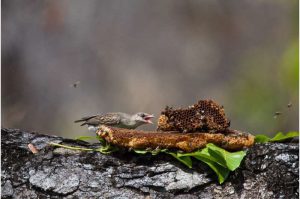
A greater honeyguide feeding on beeswax in Niassa Special Reserve, Mozambique. Credit: Dominic Cram
The honeyguide bird loves beeswax, but needs help breaking open bees’ nests to get it. So it shows a honey badger the way to the nest, who rips it open and together they share the rewards. Or so the story goes.
This Disneyesque tale of two species cooperating for mutual benefit has captivated naturalists for centuries—but is it true?
“While researching honeyguides, we have been guided to bees’ nests by honeyguide birds thousands of times, but none of us have ever seen a bird and a badger interact to find honey,” said Dr. Jessica van der Wal at the University of Cape Town, lead author of the study.
She added, “It’s well-established that honeyguides lead humans to bees’ nests, but evidence for bird and badger cooperation in the literature is patchy—it tends to be old, second-hand accounts of someone saying what their friend saw. So we decided to ask the experts directly.”
In the first large-scale search for evidence of the interaction, a team of young researchers from nine African countries, led by researchers at the University of Cambridge and the University of Cape Town, conducted nearly 400 interviews with honey-hunters across Africa.
Trail camera recording of honey badger eating beeswax and honeycomb after a human harvested a bees’ nest. Credit: Dominic Cram
People in the 11 communities surveyed have searched for wild honey for generations—including with the help of honeyguide birds.
Most communities surveyed were doubtful that honeyguide birds and honey badgers help each other access honey, and the majority (80%) had never seen the two species interact.
But the responses of three communities in Tanzania stood out, where many people said they’d seen honeyguide birds and honey badgers cooperating to get honey and beeswax from bees’ nests. Sightings were most common among the Hadzabe honey-hunters, of which 61% said they had seen the interaction.
“Hadzabe hunter-gatherers quietly move through the landscape while hunting animals with bows and arrows, so are poised to observe badgers and honeyguides interacting without disturbing them. Over half of the hunters reported witnessing these interactions, on a few rare occasions,” said Dr. Brian Wood from the University of California, Los Angeles, who co-authored the study. The report is published in the Journal of Zoology.
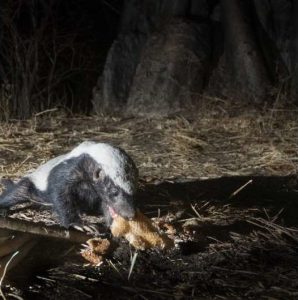
A honey badger feeding on honeycomb in Niassa Special Reserve, Mozambique. Credit: Dominic Cram
Examining the evidence
The researchers reconstructed step-by-step, what must happen for honeyguide birds and honey badgers to cooperate in this way. Some steps, such as the bird seeing and approaching the badger, are highly plausible. Others, such as the honeyguide chattering to the badger, and the badger following it to a bees’ nest, remain unclear.
Badgers have poor hearing and bad eyesight, which isn’t ideal for following a chattering honeyguide bird.
The researchers say perhaps only some Tanzanian populations of honey badgers have developed the skills and knowledge needed to cooperate with honeyguide birds, and they pass these skills down from one generation to the next.
It’s also possible, they say, that badgers and birds do cooperate in more places in Africa but simply haven’t been seen.
“The interaction is difficult to observe because of the confounding effect of human presence: observers can’t know for sure who the honeyguide bird is talking to—them or the badger,” said Dr. Dominic Cram in the University of Cambridge’s Department of Zoology, a senior author of the study.
He added, “But we have to take these interviews at face value. Three communities report to have seen honeyguide birds and honey badgers interacting, and it’s probably no coincidence that they’re all in Tanzania.”
The authors highlight the need for more scientists to engage with relevant communities and learn from their views and observations, and integrate scientific and cultural knowledge to enrich and accelerate research.
Partner switch?
The greater honeyguide bird, Indicator indicator, is well-known to communities across many African countries, where it has been used for generations to find bees’ nests. Wild honey is a high-energy food that can provide up to 20% of calorie intake—and the wax that hunters share or discard is a valuable food for the honeyguide.
Humans have learned how to read the calls and behavior of the honeyguides to find wild bees’ nests.
“The honeyguides call to the humans, and the humans call back—it’s a kind of conversation as they move through the landscape towards the bees’ nests,” said Dr. Claire Spottiswoode from the University of Cambridge’s Department of Zoology, joint senior author of the study.
With our control of fire and tools, humans are useful partners to honeyguides. We can cut down trees, and smoke the bees to subdue them before opening their nests. Honey badgers, Mellivora capensis, are more likely to make the bees angry—and aggressive bees sometimes sting the birds to death.
But honeyguide birds have been around far longer than modern humans, with our mastery of fire and tools.
“Some have speculated that the guiding behavior of honeyguides might have evolved through interactions with honey badgers, but then the birds switched to working with humans when we came on the scene because of our superior skills in subduing bees and accessing bees’ nests. It’s an intriguing idea, but hard to test,” said Spottiswoode.
More information: J. E. M. van der Wal et al, Do honey badgers and greater honeyguide birds cooperate to access bees’ nests? Ecological evidence and honey‐hunter accounts, Journal of Zoology (2023). DOI: 10.1111/jzo.13093
Journal information: Journal of Zoology
We are here to share current happenings in the bee industry. Bee Culture gathers and shares articles published by outside sources. For more information about this specific article, please visit the original publish source: DOI: 10.1111/jzo.13093
]]>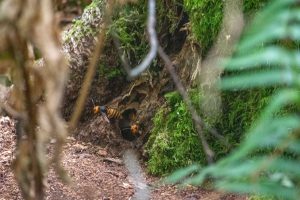
(Cover Photo: All four northern giant hornet nests in Washington State have been found in cavities of Alder trees.)
Experts Collaborate, Initiate and Succeed—Times Four
By Sharon Lucik
The first northern giant hornet (NGH) was detected in Washington State in December 2019. Ten months later, the Washington State Department of Agriculture (WSDA) found and eradicated the hornets’ nest. At the end of 2021, their staff had located and eradicated three more NGH nests. Then last year, no hornets were detected. So, what’s next? That’s exactly what PPQ aimed to find out when they traveled to Washington’s ground zero.
“We had been meeting virtually with WSDA since NGH was first detected,” said Anne LeBrun, PPQ National Policy Manager. “Finally in February we were able to have our first in-person meeting, and it was great. On the first day, the team presented on all the things that we accomplished last year and outlined plans for the upcoming season.”
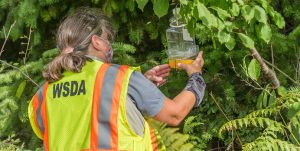
PPQ and Washington State Department of Agriculture staff intend to set a minimum of 1000 traps throughout Whatcom County, WA in 2023.
In 2023, NGH outreach and trapping continue as WSDA’s key activities, and both will be in full swing by July. If a hornet is detected, that means the presence of another nest, and capturing multiple live specimens—to tag and track back to the nest—will become critical. While PPQ and WSDA staff set and monitor traps, others will travel to the Republic of Korea—where the hornet is a native species. There the team will collect NGH specimens to analyze population genetics, test traps and lures, and study NGH’s foraging behavior.
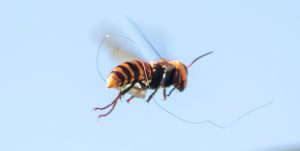
Washington State Department of Agriculture scientist successfully located and eradicated four northern giant hornet nests by tracking a tagged hornet back to its nest.
On the second day of the meeting, researchers met separately to sketch out the itinerary for the upcoming Korea trip and coordinate work. That provided LeBrun and others an opportunity to travel to Blaine, Washington to scope out where the NGH nests had been found, and experience first-hand what it’s like to hunt the largest hornet in the world—in the Pacific Northwest.
“Around Blaine the vegetation was dormant and leafless in February, but it was easy to imagine how dense and lush it would be in the summer and fall,” LeBrun explained. “Vegetation makes tracking NGH very difficult even with the telemetry tags. That said, we practiced using tracking equipment to locate a hidden tag which simulated how staff work to follow and locate a tagged hornet returning to its nest.”
Because the tags emit a signal at a pre-programed frequency, people tracking the hornet don’t hear more frequent or louder beeps as they approach the tag’s location. It’s only when they lose the signal that they know they’re going away from the target.
“All I can say is ‘hats off’ to the PPQ and WSDA trackers,” LeBrun said. “They had to learn and perfect their skills on the job, while tracking live hornets—they are truly amazing!”
We are here to share current happenings in the bee industry. Bee Culture gathers and shares articles published by outside sources. For more information about this specific article, please visit the original publish source: USDA APHIS | PPQ Travels to the Land of Giants
]]>Why Giant Hornets Rub Their Abdomens on Bee Hives Before Attack
By Paige Embry
For humans, communication is all about sight and sound, but, for many other organisms, chemicals are their primary language. We occasionally see this type of communication in action—the dog sniffing a rock and leaving his return message with a raised leg—but most of the chemical conversations going on around us are hidden from our perceptions.
We’ve identified some of these communications, and it’s pretty wondrous. Young queen honey bees, out for their nuptial flights, trail an it’s-time-to-mate scent. Pathogenic bacteria lie quietly inside a host and send out “I’m here” signals, releasing their toxins only when enough are present to potentially overcome the host’s immune system. A tree under attack may release chemicals that nearby relatives recognize as signs of impending disaster, allowing them to prepare their own defensive weaponry. Despite discoveries like these, we still understand little of the chemical conversations floating around us.
A study published in November in the Annals of the Entomological Society of America opens a window onto this means of communication for one sophisticated insect predator, Vespa soror, a giant hornet that is kin to the one that sparked a media frenzy in 2020.
Vespa soror, like its infamous cousin, is a highly social insect whose workers occasionally coordinate to attack a honey bee colony en masse. These attacks happen in the fall when hornet colonies have grown large and have many mouths to feed. Heather Mattila, Ph.D., a professor at Wellesley College, is lead author of the Annals paper. (Her work finding that Apis cerana honey bees emit alarm sounds to warn colony members of hornet attacks has also recently earned public attention.) She says that, in typical giant hornet behavior, individuals grab whatever food they can get on their own. Come fall, however, they sometimes switch to group predation, “this full court press effort to try and take over a whole colony.” How V. soror hornets choose a honey bee colony for mass attack? And how do they let their relatives know?
The van der Vecht and Richards’ glands, found only in certain eusocial wasps in the Vespinae and Polistinae subfamilies, are located on the underside of the abdomen. Shown here is an external side view (A) of the posterior abdomen of a Vespa soror worker. The black rectangle indicates the approximate area shown in microscope view (B), where dotted ovals indicate the gland locations. (S5 and S6 indicate metasomal sternites 5 and 6.) (Image originally published in Mattila et al 2021, Annals of the Entomological Society of America)
Scientists know that social insects communicate with each other (and sometimes other species as well) via chemicals released from exocrine glands—glands that secrete something outside the animal’s body. In this study, Mattila and colleagues investigate two of those glands: the van der Vecht and Richards’ glands. These glands are found only in certain eusocial wasps in the Vespinae and Polistinae subfamilies. No other wasps, bees, or ants have these glands. The researchers looked in detail at the structure of the glands, a first step in better understanding their purpose. They also studied the hornets’ rubbing behavior at a honey bee apiary to try and assess which glands are involved and the rubbings’ role in mass attacks. (See videos below.)
Both glands are located toward the end of the gaster—the part of a hymenopteran that is behind the “waist.” The Richards’ gland is smooth while the van der Vecht gland has a large brush of hair. Each gland is tucked under a sternite—one of the little plates on the underside of an insect. In certain body positions a gland is exposed, and in others the sternite acts as a kind of cap. “They have this structure that allows them to produce the pheromone but then release it to the world when they change their body posture, and part of that change in body posture could very well be rubbing,” Mattila says.
Because the glands are on the underside of the insect, it’s difficult to see which are involved in the rubbing. Nevertheless, the authors write, “Observations confirm that the van der Vecht gland is exposed during gastral rubbing but that the Richards’ gland and glands associated with the sting apparatus may also contribute to a marking pheromone.”
The scientists recorded V. soror activity over several days at an Apis cerana apiary in Vietnam. Lots of hornets were present during the study period. “Just hornets at a salad bar,” Mattila says, “grazing and grabbing bees,” and sometimes rubbing their hind ends on nest boxes or overhead vegetation. Some colonies weren’t marked or received only a rub or two. “We saw lots of marking going on that didn’t lead to a massive attack,” Mattila says. Some colonies, however, were heavily rubbed—and that heavy marking mattered. At one colony that received 26 rubbings over three hours, the hornets had, the authors write, “transitioned from hunting to attempting to breach the nest entrance.” Mattila says, “we feel pretty confident these things are linked.”
Mattila notes that a lot more work needs to be done to understand how giant hornets communicate. “I kind of cringe sometimes thinking about this whole ‘murder hornet’ label, because these are really incredible animals. They are really beautiful creatures that are doing something hardly any other social insect does,” Mattila says. “And it’s fun to see up close how their parts are built for this.”
Why Giant Hornets Rub Their Abdomens on Bee Hives Before Attack (entomologytoday.org)
]]>Expanding Texas’ integrated pest management teachings
New federal grant to implement economically, environmentally effective pest management statewide outreach
Pest management outreach to both rural and urban audiences in Texas will be expanded and improved thanks to a federal grant awarded to the Texas A&M AgriLife Extension Service.
A federal grant awarded to the Texas A&M AgriLife Extension Service will expand and improve pest management outreach to both rural and urban audiences.
The funding will help integrated pest management, IPM, experts educate thousands of Texas farmers about the latest pest management technologies and teach urban audiences about pollinator-friendly plants that promote bee and butterfly conservation.
The $812,348 grant from the U.S. Department of Agriculture National Institute of Food and Agriculture will support improvements in educational programming to meet the demands of the diverse state.
“This grant will certainly allow us to enhance our current integrated pest management program statewide and make these efforts much bigger and more far-reaching,” said David Kerns, Ph.D., integrated pest management coordinator and AgriLife Extension entomologist, Bryan-College Station.
The USDA-NIFA Crop Protection and Pest Management Program, CPPM, supports projects that will increase food security and respond effectively to other major societal challenges with comprehensive IPM approaches that are economically viable, ecologically prudent and safe for human health. The CPPM program addresses pest management challenges with new and emerging technologies. The outcomes of the CPPM program are effective, affordable and environmentally sound IPM practices and strategies supporting more vital communities.
This aligns with Texas A&M AgriLife’s efforts to identify potential methods to reduce pesticide use and associated risks in urban landscapes using IPM principles. Main focus areas for IPM in communities include:
- Management of tawny crazy ant and red imported fire ant.
- Garden pollinator promotion and conservation.
- Integrated pest management of crape myrtle bark scale.
To read the complete article go to; Expanding Texas’ integrated pest management teachings – AgriLife Today (tamu.edu)
]]>Be aware of fall’s ground nesting yellowjackets. They are NOT Honey Bees
The North Carolina, Anson Extension discusses safety when dealing with yellowjackets
The photo above shows a yellowjacket wasp.
Photo below is a friendly Honey Bee
ANSON — Hidden yellowjacket nests can become a real nuisance in the landscape this time of year, particularly when it comes to mowing or cleaning the garden. Appearance-wise, these wasps are often confused with honey bees, however yellowjackets are more slender, boldly colored, and less hairy. Honey bees are only capable of stinging once, while yellowjackets will chase trespassers and sting repeatedly.
Unlike honey bees, wasps will not overwinter, so currently the colony is focused on securing the next generation, a healthy mated queen to hibernate. By August-September a yellowjacket colony is nearing maturity and the nest may house several hundred to 1,000 individuals. The number of workers has grown all summer. They have been expanding the nest, foraging for food, defending the entrance, tending to the queen, and raising brood.
Late summer seasonal changes in weather set yellowjackets off. The current queen is laying less, the amount of available insect prey drops, and what remains is an aggregate of starving, angry wasps on the defense. In spring, aggression is generally not an issue as the nest is smaller and food is plentiful. With a nest at ground level yellowjacket larvae and adults are a favorite snack for skunks, raccoons, and bears.
Yellowjackets are considered beneficial hunters, preying on agricultural, ornamental, and turf plant pests such as caterpillars, grubs, aphids, and other insects. Also scavengers, they are attracted to other foods like meats and sweets as the number of insects diminish.
Yellowjacket nests will die out after the first hard frost, however sometimes nests need treatment due to proximity to dwellings or threat of anaphylaxis. According to NC State University, the best way to manage problematic ground nests is to use an insecticide product labeled for wasp and hornet control such as quick knock-down aerosol products that contain pyrethroid insecticides as an active ingredient. Wasp and hornet sprays are designed to be applied from a distance of 10-12’ and foam, expanding into the entrance, which increases direct contact and slow emerging wasps.
The entrance to a yellow jacket nest is a mere 1 inch wide, often hidden in a hedgerow, or other inconspicuous location. Target ground nests at night or late dusk when all the foragers have returned. Protective clothing is highly recommended. Yellowjackets are attracted to light so do not hold a flash light while applying insecticide. Check the site later in the day to determine if a second application is needed. A slower acting, but equally effective approach is to apply 2 teaspoons of 5% carbaryl insecticidal dust at the nest entrance, also at night.
Each year there are stories about using household chemicals or fuels such as bleach, gasoline, or diesel in an attempt to avoid toxic insecticides. Please don’t do this. These treatments are more toxic than most labeled pesticides, will kill desirable plants, contaminate the environment, and pose a fire or health hazard to humans. Most pesticides are designed to break down relatively quickly in the environment and are safer for your family and the environment. A final note, nuisance yellowjacket nests can be dangerous to treat without proper protective gear and clearly there is a high likelihood of being stung, so please remember a pest control professional is another option. If you have questions about structural or garden pest ID or management, contact the Anson Extension horticulture agent Aimee Colf at [email protected] or 704-694-2915.
Be aware of fall’s ground nesting yellowjackets | Anson Record
]]>WASHINGTON STATE — Scientists from Washington State said there were more than 500 Giant Asian aka Murder Hornets found in a next located back on October 22 in Blaine, Washington.
Murder Hornets are the largest hornets in the world. They can be up to 2″ long with a wingspan up to 3″. These hornets kill bees, most especially honey bees and have the potential to decimate the honey bee population.
They are not known to be aggressive towards humans, pets, or large animals unless you come near their nests.
This nest was the first Murder Hornet nest discovered in the United States. The 14″ by 9″ nest was locate 8 feet up in a tree.
Scientists said there were 6 combs with 776 cells. Each cell has the potential to hold a developing hornet.
Also in the nest:
- 6 unhatched eggs
- 190 larvae
- 108 capped sells with pupae
- 112 worker hornets
- 9 drones
- 76 queens
Image courtesy of the Washington State Department of Agriculture.
Scientists said the nest had the potential to produce up to 200 queens, each capable of starting a new nest.
The Washington State Department of Agriculture said they would continue to trap hornets and monitor the area for at least three years to make sure it is hornet-free.
https://www.thebaynet.com/articles/1120/500-murder-hornets-found-in-nest.html
________________________________________________________________________________
]]>WAPATO, WASHINGTON, October 29, 2020—A scent lure designed by Agricultural Research Service (ARS) scientists to attract Asian giant hornets played a key role in the discovery of the first nest of these invasive insects in the United States.
Washington State Department of Agriculture (WSDA) entomologists have verified several finds of Asian giant hornets in Whatcom County since December 2019. They have been actively searching for the Asian giant hornets’ nests ever since. But finding a hornet nest is a difficult hunt, even that of the world’s largest hornet, when the nest is most likely a hole in the ground or a tree.
To increase the odds of finding the nest, the WSDA team planned to live-trap some of the Asian giant hornets, fit them with radio transmitters provided by USDA’s Animal and Plant Health Inspection Service (APHIS), and track them back to the nest.
The first step was to attract the Asian giant hornets to the traps. Enter insect chemical ecologist Jacqueline Serrano with the ARS Temperate Tree Fruit and Vegetable Research Unit in Wapato, Washington. She is carrying on the work of late ARS entomologist Peter Landolt, a world leader in chemical ecology research, who developed traps and attractive lures used for wasp and hornet species like the Asian giant hornet.
“The ARS lure is a chemical mixture of acetic acid. It smells like sweet fermenting rotting fruit, which can be a food source for Asian giant hornets,” said Serrano.
The standard lure used in Asian giant hornet traps has been a blend of orange juice and rice wine vinegar. The problem is the orange juice and rice wine vinegar combination continue to ferment and get “rather gross over time,” said Serrano.
In contrast, the ARS lure is stable, so the traps don’t need to be refreshed as often.
On Oct. 21 and 22, the WSDA team caught two live hornets using the ARS lure. The team successfully fitted several Asian giant hornets with transmitters and tracked one of the hornets back to its nest in a tree cavity near the city of Blaine.
On Oct. 24, personnel from WSDA and APHIS removed the nest. They continue to use the ARS lure in the search for more nests.
The Agricultural Research Service is the U.S. Department of Agriculture’s chief scientific in-house research agency. Daily, ARS focuses on solutions to agricultural problems affecting America. Each dollar invested in agricultural research results in $20 of economic impact.
________________________________________________________________________________
]]>
For immediate release: July 31, 2020 Contact: Karla Salp (360) 902-2178
Washington traps first Asian giant hornet
OLYMPIA – The Washington State Department of Agriculture (WSDA) trapped its first Asian giant hornet this month.
The hornet was found in a WSDA trap set near Birch Bay in Whatcom County. WSDA trappers checked the bottle trap on July 14 and submitted the contents for processing at WSDA’s entomology lab. The hornet was identified during processing on July 29. This was the first hornet to be detected in a trap, rather than found in the environment as the state’s five previous confirmed sightings were.
“This is encouraging because it means we know that the traps work,” Sven Spichiger, managing entomologist for the department said. “But it also means we have work to do.”
WSDA’s next steps are to search for nests using infrared cameras and place additional traps in order to catch live Asian giant hornet specimens. WSDA Pest Program staff will deploy special traps intended to trap hornets but keep them alive. If they catch live hornets, the department will attempt to tag and track them back to their colony. Once located, the agency will eradicate the colony.
WSDA hopes to find and destroy the nest by mid-September before the colony would begin creating new reproducing queens and drones. Until that time, the colony will only contain the queen and worker Asian giant hornets. Destroying the nest before new queens emerge and mate will prevent the spread of this invasive pest.
In addition to the traps that WSDA has set to catch Asian giant hornets, citizen scientist and other cooperators have placed over 1,300 traps. Those interested in trapping can still build and set traps on their own property. Traps require weekly bait replacement and a commitment to mail the trap contents to WSDA if bees or wasps are collected. If a citizen scientist traps a live Asian giant hornet, they should call the WSDA Pest Program hotline at 1-800-443-6684.
Because the number of Asian giant hornet workers increases as a colony develops, residents should be most likely to see an Asian giant hornet in August and September. If you think you have seen one, report it at agr.wa.gov/hornets. Provide as much detail as you can about what you saw and where. Also, include a photo if you can safely obtain one, and if you come across a dead specimen keep it for potential testing.
You can visit WSDA’s website at agr.wa.gov/hornets to learn more about Asian giant hornets. You can also submit questions the WSDA Pest Program at [email protected] or 1-800-443-6684.
###
High resolution photos of the trapped specimen can be downloaded here. The photos are permitted to be used for non-commercial purposes with credit to the Washington State Department of Agriculture.
________________________________________________________________________________
]]>by Charles Linder
This is intended to question the way you look at small hive beetle. Most experts will tell you SHB don’t harm strong hives. Some have even claimed that only queenless or sick or unhygienic hives are susceptible.
None of this is new. A quick study will show you that Jamie Ellis has done some great work, and there’s a really nice paper from Clemson available online also. The only thing I add to the discussion is I believe the beetles are much more aggressive than usually mentioned. I found “The handbook of small hive beetle IPM” by Michael Hood. He also notes that at times the beetles will take over strong hives.
Small hive beetles (Aethina tumida) were found in the U.S. in 1996 and Australia in 2002. From the initial reports, they have been moving rapidly northwards. It seems cold weather is a small hindrance, soil types that allow the larva to pupate is the main requirement. They have made rapid progress spreading across the U.S. SHB tend to travel at night, and so far seem to use only beehives as a breeding area. The females lay eggs in the hive and three to eight days later hatch. The larva feed for a few days then drop to the ground to pupate. Adult females can lay up to 2000 eggs. Generally in clusters around the hive, but are also known to chew into the sides of capped cells and deposit eggs. (more on this later) The beetle larva normally matures in about 13 days, but has been reported to mature as fast as five days under good conditions.

SHB is fairly new in my area. I first noticed them around four years ago. Almost everything I read said the same thing, strong hives, full sun and no problems. Normal good practices and healthy hives and you would not have issues. Around 2010 I started seeing them. Little buggers hiding on inner covers and running. A quick squish or two and they are gone. Very few of them to start with and not every hive or yard. I bought some beetle traps but I decided they were more trouble than they were worth, as long as hives were strong, no worries is what the experts said.
The next season was a little worse. Not terrible mind you but a weak hive or two were what we call “slimed” that’s when beetle larva hatch in your supers and ruin the honey. It seems to be a combination of an excrement with a yeast that creates fermented honey. The bees avoid it. In those cases the bees were gone. Empty hives taken over I told myself the bees absconded, or were robbed out and the beetles moved it.
The next two years were a lot the same, an occasional hive wiped out, and beetles taken over, but not a lot of beetles in general. One or two in several hives, once in a while a weak hive with more than a dozen. Quick find and squash and try to get the hive back up to strength. Win a few lose a few. Most hives get inspected every two weeks. Strong ones supers added, weak ones inspected and tried to nurse up.
Then comes 2014, things changed. Late May freeze killed a lot of brood and weakened hives. Two yards in particular were having a lot of problems. If I remember correctly I lost seven hives in June. All were full of SHB larva but I racked the loss up to weak hives getting robbed out. Somehow several hives in kind of shady wet areas never seemed to bounce back.
Then comes the game changer. My pumpkin client calls and asks for more hives. His other bee supplier has called and has no bees (bad Winter and Spring I am told) so he needs another 30 hives. Well drat, that means moving honey hives into pumpkins. Normally a loosing situation, pumpkins don’t make honey. But I pick four pallets of strong doubles with supers, from the yards I lost hives in. It seemed smart, close out the yards that had few hives, and cut down my travel time. So right after the 4th of July I move double deeps out of honey yards and into pumpkin patches.
One thing you need to know about early season pumpkin yards. The ground is clean. Little to no weeds and the pumpkins have not yet spread out. So its kind of like a hardwood floor. When I went back the next day to remove supers, I find a large amount of exoskeletons out in front of the pallets. Bright white larva skeletons show up real well on bare dirt. My mid runs thru the possibilities, Pesticides? Nay just got to the field. Capped larva was not yet exposed. Moving damage? Robbing? Ants? Quick rundown makes no sense. These are two or three deep hives with a good cupful of chewed empty exoskeletons. Some almost complete, others vivisected. But just the exoskeleton of the pupa. Normal activity at the hive entrance, thousands coming and going, no sick bees, guards on duty, some bees clustered. All looks good. Time to dig.

So I opened hives. And what I found was not good. Top supers were not terrible. A few beetles and some honey, lots of bees. But then the brood nest. The first hive I picked looked like a war zone, with little hand grenades going off. Open cells with pieces of bee larva hanging out, and SHB larva everywhere. Three or four frames of it. SHB larva not in the super, but in the brood nest. Center of the hive, and the bottom board, holly heck literally thousands of beetles somewhere around two cups of the buggers. Squash kill thousands at a time. Quick search shows the queen and plenty of bees. Clean up as best I can and close the hive to regroup. Infected frames to the freezer.
I check the other hives on the pallet and SHB problems but nothing like the first. The other pallets with problems showed the same issue, SHB in the brood nest! I think there were five that were heavily infected with SHB larva and beetles. All queen right and full of bees. Probably in the 40k plus count for bees. Defiantly not weak hives that I missed! All had some viable brood. This doesn’t match. So I head home to plan and study. About that time I recall a post on the net, it mentioned finding a lot of exoskeletons of pupa in hives taken over by SHB seemed odd at the time.
Looking and researching – ‘strong hives’ that’s all you need. But then I find two Scientific articles that make a lot of sense. The first is Jamie Ellis’ work that shows clearly that hives will abscond when beetle levels get high. He tested inserting beetles into nucs. I also find tidbits from Michael Hood and Jamie Ellis – one is a paper that shows that beetles will lay eggs in capped cells. All I had read so far showed beetles laid on the honey and strong populations policed the areas and clean up the eggs. According to this the SHB lay eggs all over and try to put them in areas the bees can’t reach. His work shows that a good percentage of them are not cleaned up. He also shows evidence the beetles will use the ovipositor to place the eggs thru the sides of capped cells. When these hatch they feed on larva! Up until now I had believed pollen to be the beetles preference. Turns out they don’t much care, pollen, (I suspect an egg in pollen is hard to find) honey and now larva. In fact the honey supers in these hives seem to be infected last!
One other little tidbit of data, which matched what I had observed. Apis Melifera will chase, harass, and corral adult SHB but will totally ignore the larva. This is in slight contrast to Africanized bees which reportedly also remove larva. I suspect that is the key to the beetle’s survival that is creating more problems for us. It’s also reported that Africanized bees open up capped worker cells which contain beetle larva, something I don’t think European bees are doing. It sure appears that European bees are less defensive in general. I suspect European bee’s lower number of guard bees and guards around the periphery allow more egress for SHB than other species.


Now I had some stronger suspicions. Eyes open I started looking closer. And sure enough close observation on hives with lots of beetles (more than eight to 10 a hive) shows larva starting in the pollen band and or brood and moving thru the brood nest. Hatched larva is ignored. They don’t slime the brood like the honey which to me confirms a chemical reaction from the SHB and honey. Adult beetles are still harassed. At some point the queen stops trying to lay brood and the bees retreat. They move up into the super or upper hive until the number of bees dwindles, and at some point most abscond, usually by that time it’s a very small number of bees left. I actually watched this happen in eight hives. Watching closely over a period of two weeks, close inspection of capped bee pupae showed severe problems. Many capped cells were full of beetle larva. Pulling a larva and cutting it open shows many SHB larva feeding. One I cut open had 16 in one cell. I have counted as many as 25 in one cell. The catch is, its not every cell so it can be hard to find. They are very hard to notice until its a huge problem. Note you can see 19 dead SHB larva. There were 26 total in that capped cell.
In retrospect, I realize that beetles have been successfully breeding in bee pupae all along. Just tiny numbers. A hive with three or four beetles may be dropping a 100 or so larva a week untouched by bees. If you assume say 10 SHB larva per bee pupa, that’s only 10 contaminated bee pupa in a hive! If they were not succeeding already, the older ones would soon be gone, and no one I have ever talked to has seen them disappear.
I think what we are missing is noticing a few pupae here and there that are literally being consumed by SHB. If the infected pupa is removed by the bees the SHB may be pupating from that point. If you look close you will see a few larva on the bottom boards, and one thing for sure SHB larva are extremely mobile. Moving 30-40 feet across a concrete floor is not uncommon.
Of course this makes me ponder the conventional wisdom and what’s changed? First off, I am not convinced it has changed. One thing to note is that SHB takeover happens quickly. Beetles hatch in three days. Most of us don’t do full inspections that often. Another factor that I ponder in retrospect, 2012, and 2013 were very dry years. Drought conditions for my area most of the year. This year was wet, very wet. And the hives with issues were on wet low ground, and shaded.
What I suspect is this wet weather has allowed the larva to successfully pupate at a very high ratio, so small populations of beetles turned into large populations very quickly. Hives that were strong were not inspected real close, and the bees allowed the early season beetle larva to escape and pupate. Suddenly there is an invasion, exceeding an economic threshold. The beetles then lay in the brood nest and pollen band at a rate the bees cannot keep up with. And suddenly literally within a five day window the brood nest is totally destroyed. Total collapse is shortly following.
What I am sure of is that SHB turn from parasite to predator when the conditions are right. And that is not just weak hives. What does this mean? Well in the end the only difference is Beekeeper attitude. Instead of ignoring them it’s time to start being active in prevention.
So what to do? First where did they come from? Hives moved in the area and Nucs seem to be the main sources. A.I. Root touted packages back in the day as a way to get clean bees. No disease from the comb. Still viable but I can promise you beetles get shaken into packages also. There is a product called the Beebus which is for packages designed to let SHB out of the cluster. Many suppliers are using them. I personally noticed them in packages, hiding behind the center bars and in the corners. Prevention of getting them in the first place is a good start. Typically packages that come from dry sandy soil also should be clean. Any nucs should be THOROUGHLY inspected.
Look closely at the soil conditions where you place hives. Dry soil in full sun will slow down beetle growth. Wet, damp shaded or irrigated soils, favor the beetles.
Treatment
After learning what I did, it was time to go on offense. Gardstar ground drench was used everywhere. Normally I shun pesticides, but this time was different. I needed to stop the larva. A few of oil trays were ordered and placed under the worst hives. 200 beetle barns were installed, at least two in each hive. I started with Checkmite. Coumaphos in the Checkmite seems to work very well, Beetle jails with vinegar in the middle section oil in the outsides also work, but can be a pain to handle.
This Winter I will be doing powder sugar treatments, not for mites, but for SHB. Put the hive on an oil tray and dust it. The sugar seems to agitate the bees into harassing the beetles more than usual. You will see a huge drop of beetles in the first five to 10 minutes.
Screened bottom boards are a thing of the past for me. I think it is too easy for that Larva to drop to the ground, I have also used this as another reason to switch to top entrances. The bottoms of my hives are pretty well sealed, in the hopes of stopping the larva from reaching the ground. Pollen patties must be watched closely, and beetles will successfully hatch and grow in division board feeders. I am currently testing on weather or not they escape the feeders to pupate or eventually drown.
I also notice in my area around September 1 the beetles stop laying eggs. Around the same time I noticed less harassment by the bees in general. Beetles moving around frames pretty much at will, little to no harassment. Not sure why, but I am sure there is less harassment than there was in the summer months. This allows the beetles to Winter well inside the cluster.
One key is don’t wait. Once you spot a beetle, be proactive, another note to consider, your location. Beetles need soft moist soil to pupate. Many areas of the country will never have issues. Most of the southwest will remain beetle free I suspect. Those in the southeast however know better. I suspect that is why hives in full sun don’t seem to get bothered as much.
I also suspect that weather will be an issue. Wet weather favors the beetles. Don’t think cold bothers them. Adults Winter in the cluster with the bees. Normally several of them in a cell I have found many in dead outs this way, and several small Spring cluster full of beetles, before any real pollen flows. For those of you without beetle problems, stay vigilant and thankful, but when those with problems tell you they lost a hive, don’t assume it was their beekeeping skills. Understand that at times it doesn’t matter, the beetles can and do take down good hives.
]]>by Andrea Quigley
Two months ago, we looked at the woes of Calabrian beekeepers facing bankruptcy as their apiaries were burned if the Small hive beetle (Aethina tumida, ‘the beetle’) was detected. This month we ask why it didn’t arrive in Europe sooner, what some neighboring countries are doing to protect themselves and the latest position in Italy.

Small Hive Beetle is indigenous to sub Saharan Africa, that is the land lying south of the Saharan desert including Southern Sudan1. There it co-exists with local strains of honey bee that have adapted to live alongside it. The beetle was first found in Egypt during Summer 2000 and was likely introduced by humans. The beetle’s range now includes the Nile delta2 but, unsuited to arid climates, the dry soils and desert prevent it infesting a larger area of Egypt. Neither has it spread from Egypt to Israel, mostly due to the local geography. A large expanse of desert, some of it mountainous, spans across the region forming a natural barrier. Human activities that might have introduced the beetle to neighboring Israel have been restricted due to the political tensions between those countries. Had the beetle reached Israel, it is possible the beetle would have spread around the Mediterranean countries.
European countries observed the experiences of the United States and Australia, and planned accordingly. For example, in 2010, the UK made a formal analysis3 to consider how the beetle might arrive in the UK. The report concluded the key risks are:
- “Movement of honey bees: queens and package bees (workers) for the purposes of trade.
- Movement of alternative hosts e.g. bumble bees for pollination purposes.
- Trade in hive products – e.g. raw beeswax and honey in drums.
- Soil or compost associated with the plant trade.
- Fruit imports – in particular avocado, bananas, grapes, grapefruit, kiwi, apples, mango, melons and pineapples – Small hive beetle may oviposit (lay eggs) on fruit.
- Movement on beekeeping clothing/equipment.
- Movement on freight containers and transport vehicles themselves.
- Natural spread of the pest itself by flight, on its own or possibly in association with a host swarm.”
The 2013 European Food Safety Authority (EFSA)4 report analyzed the risks and likelihood of the beetle arriving in Europe. Clear knowledge gaps were noted. The review concluded “[more] research is needed to ascertain the risk of SHB entry via products such as ripe fruits and soil associated with plants.” This was compounded by the warning that “Accidental bee import (unintended presence of bees in a non-bee consignment) is associated with a high risk of entry . . . since an infested consignment might not be detected.” All too late now, given the belief is that the beetle arrived on ripe fruit in Gioia Tauro, Italy.
Most countries have their own means of monitoring and dealing with “exotic” pests and diseases; “exotic” meaning those pests and diseases alien to a country. Within the EU, the member countries agree upon the appropriate control measures that each member must enforce. In the UK, this is done by the National Bee Unit (“NBU”), part of the Animal and Plant Health Agency. Teams of bee inspectors operate through the UK, although the Scottish and Northern Ireland inspectors report to the agricultural departments within their home governments. The inspectors and the NBU identify risk areas and place bait or sentinel hives nearby which are routinely checked. Likely places include airports, e.g. London Heathrow, ports and harbors, e.g. Dover, Liverpool and Southampton (Figure 1). If a small hive beetle were found then a rapid assessment would follow to uncover the extent and spread of any infestation under emergency measures. Steps would then be taken to eradicate or to contain and control the beetle depending on the degree of infestation.
With the discovery of the beetle in Italy, neighboring countries fear it will cross their borders and infest their colonies. Figure 2 shows relative distances as the crow flies from Calabria to locations in other European countries. These distances indicate the potential spread across Europe of this pest could take years and suggest infestation (at least in the short term) is not inevitable. Yet, the small islands of Malta and Gozo, with their own race of honey bees Apis mellifera Ruttneri, are closer to the outbreak than is the Italian capital of Rome. Understandably, the Maltese are really concerned. The ancient Greeks and Romans first named Malta as Melite (Μελίτη) and Melita respectively. These names mean “the land of honey.” To protect their land of honey, the Maltese issued an immediate and outright ban on movement of bees from Southern Italy, effective from 19 November 2014. A spokesman for the Maltese Plant Health Directorate said, “This beetle poses a serious threat to bees in Malta. For this reason, it has been decided to prohibit the importation in Malta of live bees from these affected areas, including bees used for the purpose of pollination.”
In the UK, beekeepers have watched recent developments with alarm. To a certain extent, the British Isles are protected since they are separate from the European mainland. Moreover London, UK, is some 1,202miles (1,938km) from Calabria; roughly the distance between New York City and New Orleans. However, fruit and plants (in soil) are regularly imported into the UK from Italy. One barrier to simply blocking movements of these products is a key EU principle “the freedom of movement of goods”. This means no EU state may block routing of goods into their country unless there is a clear threat to human health or the environment. Whilst beekeepers would argue that is the case, the UK government has not yet intervened to protect British bees. Many petitions have been raised, including one from the Scottish Beekeepers’ Association (“SBA”). On 2 December, the SBA wrote to the Scottish government to urge that “all possible measures are taken to prevent the introduction of small hive beetle into the UK. These should include a cessation of trade in live bees from the rest of Europe for 2015 until the true spread of the beetle is known.

Deep concerns have been raised by the British Beekeepers’ Association (“BBKA”) and others at the UK Bee Health Advisory Forum, a group of leading beekeeping groups and scientists working with government policy makers and bee experts. The BBKA says “[we have] urged restriction of the trade in plants, fruit and vegetables from the SHB exclusion zone in Italy, into the UK.” The BBKA is unhappy that plant health authorities, after consultation with bee health policy officials, state that “they do NOT have legal powers to stop the entry of plants, fruit and vegetables from Italy under plant health legislation.” The BBKA has urged them to “reconsider this aspect under the terms of animal health provisions”.

Figure 1. The risk areas for apiaries should an exotic pest arrive in England and Wales. Source: Beebase, Crown copyright.
The BBKA also says that the additional measures taken are inadequate. These include (1) supply of a National Bee Unit advisory leaflet to the Fresh Produce Consortium who will pass on copies of this leaflet and inform their members of the risk of importing the beetle in their goods; and (2) HM Customs and Excise will monitor all arrivals to the UK together with the Plant Health and Seeds Inspectorate which inspects plants, fruit and vegetables on importation; they have been given information on how identify the beetle.
Until this outbreak, it was possible to freely move bees across borders within the EU provided a certificate of good health was available. With the current restrictions, the movement of bees is blocked from the affected region. The UK has almost no queen producers and the market for package bees is small. In 2014, UK beekeepers bought from Italy 1,767 queens (18% of all queens imported from the EU) and 1,202 package bees (85% of all packages imported from the EU). For many years, neither colonies nor package bees could be imported into the UK from countries outside the EU. EU law is similarly strict but also permits imports of bees from New Zealand. Given the Italian outbreak, UK bee inspectors re-inspected all bees imported from Italy during 2014. No beetles were found.
Some Swiss, German and Austria beekeepers move their bees to Italy each fall to avoid Winter colony losses and to build strong colonies for the Spring. Calabria is often chosen because good supplies of pollen and nectar are available for most of the Winter; with citrus trees flowering in January. During fall 2014, Swiss and German16 beekeepers were advised if they have not taken their bees to Italy already then they should not do so. Uwe Büchner, spokesman for the Thuringen Ministry responsible for veterinary affairs, has asked beekeepers to leave their bees in Italy. In Austria, beekeepers are reminded that throughout Europe the beetle must by law be reported to the authorities. Beine Ӧsterreich (Austria Bee) advises its members that, in line with EU law, bees may not be moved from the “standstill” or red zone in Calabria and Sicily. Simply put, any bees migrated to Calabria for the Winter must remain there for fear of bringing the beetle home. On 12 December, the EU formally banned any movement of honey bees, bumble bees, bee equipment and hive products from Calabria and Sicily to anywhere in the EU or the European Economic Area (“EEA”). The EEA is free trade zone comprising 31 countries, including 28 EU member states and three members of the European Free Trade Association (Iceland, Liechtenstein and Norway). The ban permits movement of refined and processed beeswax together with honey intended for human consumption (but not comb honey). It expires on 31 May 2015 when it will be reviewed.
Both beekeepers and the officials in the affected area feel misunderstood. The beekeepers state they are doing everything they can to find the beetle and to comply with current measures but are fearful they will lose their livelihoods. In contrast, the inspectors have been accused of being too ready to burn everything and not doing enough to control the beetle. Both sides seem to be working hard and recent meetings may have helped ease tensions. New laws have been introduced to cover the beetle and its control. For example, penalties exist for failure to report presence of an apiary in the surveillance zone.
In Italy on 1 December, beleaguered beekeepers received some good news that they will receive compensation for the loss of their hives should they be destroyed to control the beetle. They may also receive compensation also for “loss of trade” and the “possible effects through loss of pollination.” Moreover since December 11, only one new case has been confirmed; the number of cases is now 60 infested apiaries. Over 3,500 colonies have been destroyed. On 11 December, Dr. Silvio Borrello, managing director for animal health, the Italian Ministry of Health, met with beekeeping groups and experts when beekeepers asked again for a switch to managing rather than eradicating the beetle. The Ministry of Health will reconsider its approach to incineration on 19 February which, coincidentally is the day when COLOSS’s new Small Hive Beetle task force will meet in Bologna. For now, the Ministry has reconfirmed that the existing crisis measures would remain in force. They remain hopeful that the outbreak will be eradicated. Yet it remains to be seen as the pollination season gets underway whether truly the beetle has been eradicated from Italy.

References
1El-Niweiri, M.A.et al (2008) Filling the Sudan gap: the northernmost natural distribution limit of small hive beetles. Journal of Apicultural Research 47(3): pp 184–185 DOI: 10.3827/IBRA.1.47.3.02
2Hassan, A. R. and Neumann, P, (2008) A survey of the small hive beetle in Egypt. Journal of Apicultural Research 47(3): 186–187 DOI: 10.3827/IBRA.1.47.3.03
3Brown, M. and Learner, J. (2014) The Small hive beetle Aethina tumida (SHB) http://www.nationalbeeunit.com/downloadNews.cfm?id=125
4EFSA Panel on Animal Health and Welfare (2013) Scientific Opinion on the risk of entry of Aethina tumida and Tropilaelaps spp. in the EU. EFSA Journal;11(3): 3128
1. Keep your cat indoors (http://www.abcbirds.org/abcprograms/policy/cats/index.html) —This is best for your cat as well as for the birds, as indoor cats live an average of three to seven times longer. Domestic cats, which are not native to the United States, are an introduced predator against which birds have no defense. Cats are responsible for an estimated 2.4 billion bird deaths each year. Some species have gone extinct because of cats! Even well-fed cats instinctively kill birds, and bells on cats don’t effectively warn birds of cat strikes. In the spring, young birds or nestlings often find themselves on the ground calling for a parent, only to end up attracting the fatal attention of a nearby cat. Because of this, studies show that bird mortality from cats in the spring is disproportionately higher when compared to other times of the year.
2. Prevent birds hitting your windows by using a variety of treatments (http://www.abcbirds.org/newsandreports/releases/120221.html) to the glass on your home. Collisions (http://www.abcbirds.org/abcprograms/policy/collisions/glass.html) with glass constitute a major source of bird mortality, with as many as one billion dying each year. See ABC’s new flyer! (http://www.abcbirds.org/abcprograms/policy/collisions/pdf/collisions_flyer.pdf)
3. Eliminate pesticides (http://www.abcbirds.org/abcprograms/policy/toxins/pesticides.html) from your yard—even those pesticides that are not directly toxic (http://www.abcbirds.org/newsandreports/releases/130319.html) to birds can pollute waterways and reduce insects that birds rely on for food—and try to buy organic food to help reduce pesticide use on farms. For rodent control, seal cracks, remove food sources, and use snap and electric traps rather than rodenticides, which poison birds as well as young children. Learn more here (http://www.abcbirds.org/abcprograms/policy/toxins/what_you_can_do.html) .
4. Create backyard habitat—yards both large and small can benefit birds and other wildlife. Create a diverse landscape by planting native grasses, flowers, and shrubs that attract birds. You will be rewarded by their beauty and song, and will have fewer insect pests as a result.
5. Donate (http://www.aba.org/bex/) old bird-watching equipment such as binoculars or spotting scopes to local bird watching groups—they can get them to schools or biologists in other countries (http://opticsforthetropics.org/) who may not have the resources they need. More people studying birds means more voices for bird conservation!
6. Reduce your carbon footprint—use a hand-pushed or electric lawnmower, carpool, and use low-energy bulbs and Energy Star appliances. Less energy used means less habitat destroyed for energy production.
7. Buy organic food and drink shade-grown coffee—increasing the market for produce grown without the use ofpesticides (http://www.abcbirds.org/abcprograms/policy/toxins/pesticides.html) , which can be toxic to birds and other animals, will reduce the use of these hazardous chemicals in the U.S. and overseas. Shade coffee farms have been demonstrated to provide far superior habitat for birds than coffee grown in open sun.
8. Keep feeders and bird baths clean (http://birding.about.com/od/birdfeeders/a/feedercleantips.htm) and change the water regularly to avoid disease and prevent mosquitoes from breeding.
9. Support bird-friendly legislation—Example: HR 1643, a proposed bill that provides for bird-friendly federal buildings. Take a look at the ABC action center (http://www.abcbirds.org/action/index.html) .
10. Join a bird conservation group such as ABC (http://support.abcbirds.org/join) (click on ABC to learn how to join)—learn more about birds and support important conservation work. The upcoming issue of ABC’s Bird Conservation magazine features migratory birds.
“Protecting and helping birds is not only the right thing to do, it is also good for the economy and the future of our environment. Birds are invaluable as controllers of insect pests, as pollinators of crops, and dispersers of native plant seeds, and they also generate tremendous economic revenues through the pastimes of bird feeding and bird watching,” said Fenwick.
A federal government study reports that over 20 percent of the U.S. population – 48 million people – participates in bird watching. Of that total, about 42 percent (20 million people) actually travel to see birds. Birders spend about $36 billion annually in pursuit of their pastime. The top five bird watching states by percentage of total population are: Montana (40%); Maine (39%); Vermont (38%); Minnesota (33%); and Iowa (33%).
]]>